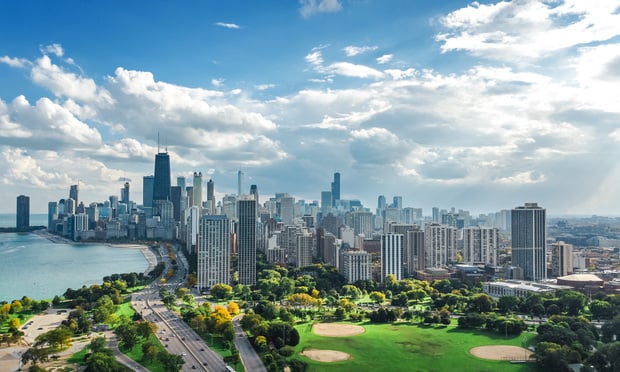LOS ANGELES—CBRE Group, Inc. recently launched a research project to study green buildings in the US, and its first analysis found that among US cities Minneapolis had the highest percentage of green commercial space, a result that surprised many.
“Going in, I thought we would find that this was much more of a bicoastal phenomenon,” Dave Pogue, CBRE's global director of corporate responsibility, tells GlobeSt.com. But 77% of the commercial space in Minneapolis was certified as green. Other top cities include: San Francisco, which came in second with 67.2%; Chicago, which came in third with 62.1%; Houston took fourth place with 54.8%, and Atlanta rounded out the top five at 54.1%.
“Chicago did not surprise me as much,” Pogue adds, even though it is not a coastal city. “This is a first-tier market with a lot of high-profile owners and green-certified buildings also tend to be a big city phenomenon.”
The new study, dubbed the 2014 Green Building Adoption Index, is a joint project of Los Angeles-based CBRE, the US Green Building Council and Maastricht University in the Netherlands. Led by Dr. Nils Kok of Maastricht, researchers combed through Environmental Protection Agency Energy Star and USGBC LEED statistical data from 2005 through 2013. They studied more than 34,000 buildings totaling more than 3.5-billion-square-feet in the CBDs of the top 30 US markets.
“This is the first study to quantify the relevance of green building practices in the commercial real estate market,” says Kok, an associate professor of finance. “While we all know examples of LEED-certified buildings, the results presented here are facts based on a robust methodology, not anecdotal evidence.”
“Our primary goal was to understand how prominent green buildings were,” adds Pogue, and have the ability to inform clients whether they were falling behind in the implementation of green methods and technologies, or if attaining Energy Star and LEED certifications would transform their buildings into market leaders. But considering how prevalent green certifications have become, “you may have a disadvantage if you're not green.”
“Green is the new norm,” he says. Since 2005, Energy Star-labeled buildings increased nearly 600%, and the proportion of buildings that received LEED certifications increased from less than 0.5% in 2005 to 5.0%, a more than 1,000% increase. And measured by floor area, LEED-certified space now totals 19.4% of the total building stock in the 30 office markets reviewed.
This study is just the first completed under CBRE's Real Green Research Challenge. Launched in September 2012, the $1 million project will continue to fund sustainability research. Pogue says he hopes to release new data on an annual basis and perhaps expand the research to include retail and industrial properties.
Continue Reading for Free
Register and gain access to:
- Breaking commercial real estate news and analysis, on-site and via our newsletters and custom alerts
- Educational webcasts, white papers, and ebooks from industry thought leaders
- Critical coverage of the property casualty insurance and financial advisory markets on our other ALM sites, PropertyCasualty360 and ThinkAdvisor
Already have an account? Sign In Now
© 2024 ALM Global, LLC, All Rights Reserved. Request academic re-use from www.copyright.com. All other uses, submit a request to [email protected]. For more information visit Asset & Logo Licensing.








